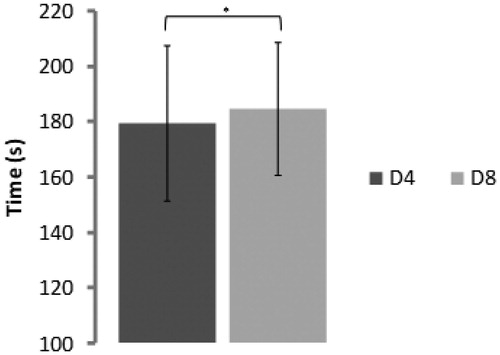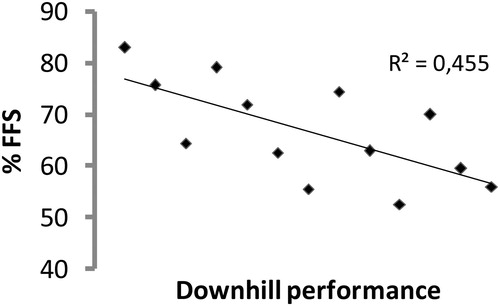 ?Mathematical formulae have been encoded as MathML and are displayed in this HTML version using MathJax in order to improve their display. Uncheck the box to turn MathJax off. This feature requires Javascript. Click on a formula to zoom.
?Mathematical formulae have been encoded as MathML and are displayed in this HTML version using MathJax in order to improve their display. Uncheck the box to turn MathJax off. This feature requires Javascript. Click on a formula to zoom.1. Introduction
Trail running (TR) is characterized by sequences of uphill and downhill performed in a natural environment. Recently, studies investigated performance factors specific to TR. During a full race of TR, Ehrström et al. (Citation2018) highlighted that performance is depending on (1) (2) running economy and (3) local endurance of lower limbs. However, elite athletes seem to make a difference in downhill sections more that in uphill during short TR races. For that matter, Juillaguet et al. pointed out that performance in downhill was related to (1) muscular (high quadriceps rate force development), (2) perceptive (fast visual based decision making), (3) psychological (disposition to take risks) and (4) biomechanical (low percentage of rear foot strikes) factors (Juillaguet et al. Citation2018). However, Horvais and Samozino (Citation2013) highlighted that shoe drop (i.e., the difference of height between heel and toes in the shoe) highly influenced foot strike pattern (FSP). Indeed, runners changed their FSP from rear foot strike to mid/fore foot strike when using low drop shoes. Moreover, low drop shoes may also induce a better running economy, especially on flat sections (Vercruyssen et al. Citation2016). Given that these studies only investigated flat and uphill sections, no relevant information could be found for downhill sections. Well, Juillaguet et al. pointed out that performance in downhill was influenced by biomechanical factor (low percentage of rear foot strike). The purpose of this study was to determine whether using shoes with different drops can increase performance in downhill. It was hypothesized that trail-runners would be faster in a short downhill section with lower drop shoes.
2. Method
2.1. Participants
Thirteen male experienced trail-runners participated to this study (age: 23 ± 5 years, height: 180 ± 6 cm, weight: 66 ± 4 kg, training/week: 5 ± 2, experience in TR: 4 ± 2 years).
2.2. Study design
The study took place in a natural environment. 800-meters downhill section with 200 meter negative elevations (i.e. gradient of approximately 25%). A short section was chosen to eliminate the influence of neuromuscular fatigue. Subjects had to realize a specific warm-up, followed by a downhill preview. Then, they had to realize two timed downhills with two pairs of shoes in a random order: a 4 mm drop shoe (D4) and an 8 mm drop shoe (D8). Except the drop difference, all technical features between shoes were the same. A recovery period of 20 minutes was given to the subjects between the two downhills. Participants were instructed to run as fast as possible.
2.3. Data collection
Each participant’s right shoe was equipped with two triaxials accelerometers (Hikob Agile Fox, Hikob, Villeurbanne, France). One was placed at the back of the heel and the other above the metatarsal area. Accelerometers were secured with adhesive tape. Accelerations of the three axis were recorded at 1344 Hz directly onto a memory card embedded in the sensor. All recorded data was analyzed with SciLab 5.5.2 (Scilab Enterprises, Orsay, France). For each foot strike, the time between the acceleration peak of the heel and the metatarsus (THM) was calculated. Then the percentage of rear foot strikes (%RFS), mid foot strikes (%MFS) and forefoot stries (%FFS) were determined based on this THM (Giandolini et al. Citation2014).
2.4. Statistical analysis
Data are presented by their mean ± standard deviation. Statistical analysis was performed with the Statview software (version 5.0). To compare results according to different conditions, a paired t-test was used. The relationship between biomechanics (%FFS and %RFS) and downhill time according to the shoe assessed using a Pearson’s linear correlation. Significance threshold was fixed at p < 0.05.
3. Results and discussion
Results showed a 3% lower downhill time with the D4 shoe compared to the D8. Downhill times were 179 ± 28 s and 185 ± 24 s respectively (). Moreover, %RFS and %MFS were significantly higher with the D8 shoe than with the D4. Conversely, %FFS was significantly higher with D4 than with D8.
Figure 1. Downhill time with different drop shoes. s: seconds; D4: 4 mm drop shoe; D8: 8 mm drop shoe.

Therefore, runners were faster with D4 than with D8. This result is explained by a modification of FSP from rear/midfoot strike to forefoot strike dominance. Furthermore, %FFS was higher with D4 than with D8 and there is a relationship between %FFS and performance (). Our results are emphasizing with Juillaguet et al. (Citation2018) which suggest that an alteration of biomechanical factors will increase downhill performance. In accordance with this findings, lower drop shoes could also permit improvement of running economy as suggested by Vercruyssen et al. Citation2016. This result is also described by Di Michele and Merni (Citation2014) who highlighted that higher %FFS is related to lower ground time contact, leading to better adaptations for trail-runners on specific and unpredictable tracks.
4. Conclusion
To date, elite athletes are searching marginal gains to increase performances. Our results showed that using a low drop shoes (D4) allows modification of FSP from a rear foot strike pattern to a forefoot strike pattern and thus increase downhill performance. So, selection of material (shoes with different technical features) could influence performance in downhill TR.
References
- Di Michele R, Merni F. 2014. The concurrent effects of strike pattern and ground-contact time on running economy: ScienceDirect. J Sci Med Sport. 17(4):414–418.
- Ehrström S, Tartaruga M.P, Easthope C.S, Brisswalter J, Morin J.-B, Vercruyssen F. 2018. Short trail running race: beyond the classic model for endurance running performance. Med Sci Sports Exercise. 50 (3):580–588.
- Giandolini M, Poupard T, Gimenez P, Horvais N, Millet G.Y, Morin J.-B, Samozino P. 2014. A simple field method to identify foot strike pattern during running. J Biomech. 47 (7):1588–1593.
- Horvais N, Samozino P. 2013. Effect of midsole geometry on foot-strike pattern and running kinematics. Footwear Sci. 5 (2):81–89.
- Juillaguet R, Pavailler S, Giandolini M, Cassirame J, Horvais N, Doucende G. 2018. Model of performance in downhill trail running: a multifactorial approach. Paper presented at 5th Annual Congress on Medicine & Science in Ultra-Endurance Sports, May 9–10, Castelló de la Plana, Spain, At Plana Spain.
- Vercruyssen F, Tartaruga M, Horvais N, Brisswalter J. 2016. Effects of footwear and fatigue on running economy and biomechanics in trail runners. Med Sci Sports Exercise. 48(10):1976–1984.

